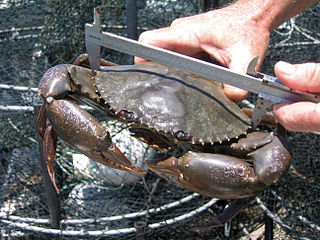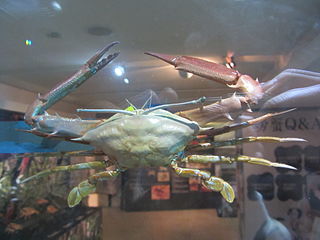
Crabs are decapod crustaceans of the infraorder Brachyura, which typically have a very short projecting tail-like abdomen, usually hidden entirely under the thorax. They live in all the world's oceans, in freshwater, and on land. They are generally covered with a thick exoskeleton. They generally have five pairs of legs, and they have pincer claws on the ends of the frontmost pair. They first appeared during the Jurassic period, around 200 million years ago.

Scylla serrata is an ecologically important species of crab found in the estuaries and mangroves of Africa, Australia, and Asia. In their most common forms, their shell colours vary from a deep, mottled green to very dark brown.

Scylla paramamosain is a mud crab commonly consumed in Southeast Asia.

Portunus pelagicus, also known as the blue crab, blue swimmer crab, blue manna crab and flower crab is a species of large crab found in the Indo-Pacific, including off the coasts Indonesia, Malaysia, Cambodia, Thailand, the Philippines, and Vietnam; and in the intertidal estuaries around most of Australia and east to New Caledonia.

Portunidae is a family of crabs which contains the swimming crabs. Its members include many well-known shoreline crabs, such as the blue crab and velvet crab. Two genera in the family are contrastingly named Scylla and Charybdis; the former contains the economically important species black crab and Scylla paramamosain.

The Ocypodidae are a family of semiterrestrial crabs that includes the ghost crabs and fiddler crabs. They are found on tropical and temperate shorelines around the world.

Charybdis is a genus of swimming crabs in the family Portunidae. It is named after the monster Charybdis of Greek mythology.

Portunoidea is a superfamily of crabs that includes the family Portunidae, the swimming crabs. Which other crab families are also placed here is a matter of some contention, and may be revised following molecular phylogenetic analyses.

Scylla tranquebarica is a species of mangrove crab in the genus Scylla. Scylla tranquebarica, one of several crabs known as the mud crab, is found in mangrove areas from Pakistan and Taiwan to the Malay Archipelago and other Indo-Pacific regions.

Scylla is a genus of swimming crabs, comprising four species, of which S. serrata is the most widespread. They are found across the Indo-West Pacific. The four species are:

Matutidae is a family of crabs, sometimes called moon crabs, adapted for swimming or digging. They differ from the swimming crabs of the family Portunidae in that all five pairs of legs are flattened, rather than just the last pair, as in Portunidae. Crabs in the Matutidae are aggressive predators.

The Panopeidae are a family containing 26 genera of morphologically similar crabs, often known as "mud crabs". Their centers of diversity are the Atlantic Ocean and eastern Pacific Ocean.
Charybdis longicollis, the lesser swimming crab, is a species of crab from the swimming crab family, the Portunidae. It has a native range which covers the north-western Indian Ocean and it has invaded the Mediterranean Sea by Lessepsian migration through the Suez Canal.

Latreillia elegans is a species of crab belonging to the family Latreilliidae. This family of crabs is identified by their appearance as small, long-legged crabs. The species belongs to the genus Latreillia which has only five identified species: L. elegans, L. metanesa, L. williamsi, L.valida, and L. pennifera. It was previously thought that L. elegans and L. mannengi were two separate species, but it has since been revealed that the two species are synonymous. All the thought to be differences between L. elegans and L. mannengi were in actuality overlaps. The L. mannengi is simply referring to the close relative to the species of L. elegans found in the western Atlantic.
William Stephenson MBE (1916–1996) was a British/Australian marine biologist and academic.
Leptuca batuenta, commonly known as the beating fiddler crab, is a species of fiddler crab native to the tropical eastern Pacific, from El Salvador to northern Peru.

Podophthalmus vigil is a species of swimmer crab found in tropical areas of the Indo-Pacific Ocean, including Hawaii, Japan, South Africa, the Red Sea, Australia. In Australia the crab is found across the north from Exmouth to Moreton Bay. It is commonly known as the Long-eyed swimmer crab Stalk-eyed swimmer crab, Red crab, or Periscope crab. Like other swimmer crabs the last pair of legs have flattened ends to form paddles. Colors include a greenish brown carapace with possible red spots, claws and legs pale violet, rose red or dark red. The carapace is typically up to 100mm across, very broad at the front, narrow at the back with a spine on each side. There is a single tooth behind the spine. Males are larger than females and have more elongated limbs.

Macrophthalmus crassipes is a species of sentinel crab in the family Macrophthalmidae, found around China, Thailand, Malaysia, Australia, and the Caroline Islands. In Australia it is found from north Western Australia through to New South Wales. Common names include the seagrass sentinel crab and the orange spined sentinel crab. On adult males there is a substantial tooth on the lower claw and a much smaller tooth on the upper claw, and noticeable orange spines on the “wrist” (carpus) of the clawed leg and on the palm of the clawed leg. The carapace is covered in small granules, and is up to around 37 mm (1.5 in) across. It is a burrowing crab, and lives in open tidal flats, muddy or with sandy mud, low on tidal creek banks, and adjacent mangroves.

Portunus armatus is a species of crustacean, a swimming crab in the family Portunidae found in Australia and eastwards to New Caledonia. Common names include blue swimmer crabs, Blue manna, Blueys, and Jennies. The species was originally considered as a geographic variation of Portunus pelagicus, however in 2010 the Portunus pelagicus species was reviewed using DNA, as well as physical characteristics including measurements and four species recognised: Portunus pelagicus, Portunus armatus, Portunus reticulatis and Portunus segnis. The range of Portunus armatus overlaps with Portunus pelagicus in the Northern Territory of Australia.

Tiomanium indicum, commonly known as the Tioman crab or the white clawed mangrove crab, is a crab in the family Sesarmidae. It inhabits the Western and central Indo-Pacific ocean, including Singapore, Malaysia, Australia (Queensland), the Philippines and New Guinea. Tioman crabs are supralittoral. In Cairns, Australia they are known for moving in numbers in some seasons entering backyards and homes. This species was originally described by H. Milne Edwards in 1837 as Sesarma indicum. It was placed in a new genus Tiomanium by Serene and Soh The carapace is convex and 34 mm length. Key features that differentiate Tiomanium from Neosarmatium include a spine at the end of the upper inner margin of the cheliped palm and a spine on the upper inner angle of the carpus.
















